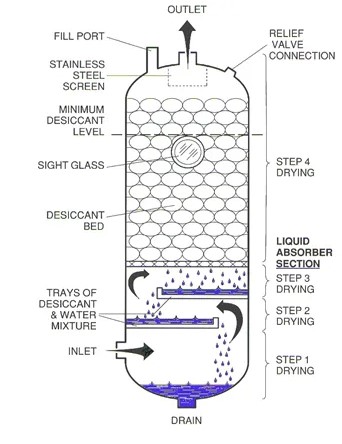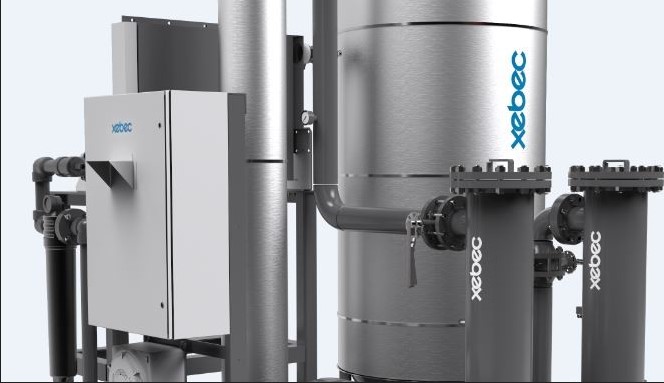Moisture control is an essential aspect of many industries, including food preservation, pharmaceuticals, electronics manufacturing, and more. It helps in extending the shelf life of products, ensuring the stability of pharmaceuticals, and maintaining the integrity of electronics. The fight against moisture is not new; however, the methods and materials used have evolved significantly.
The key players in moisture control are desiccants and deliquescent substances. Desiccants are materials that absorb moisture from the air, thereby creating a dry environment. Deliquescent substances, on the other hand, absorb moisture to the point of dissolving in the absorbed water. Although they serve similar purposes, their mechanisms and applications vary greatly.
Desiccants, such as silica gel and activated alumina, work by adsorbing moisture onto their surface, while deliquescent materials like calcium chloride and magnesium chloride absorb moisture and then dissolve into it. This fundamental difference in how they interact with moisture dictates where and how they are used, from industrial processes to the packaging of everyday products. The choice between desiccant and deliquescent depends on the specific needs of moisture control, including the degree of dryness required and the environmental conditions.

Basics of Moisture Control
What is Moisture Control?
Moisture control involves strategies and methods to eliminate or reduce moisture in environments or materials. It is vital for protecting products, extending shelf life, and ensuring the stability of structures and materials. Effective moisture control prevents mold, corrosion, decay, and other moisture-related damage.
Why Moisture Matters
Preservation
Moisture can lead to the deterioration of various materials, including food, textiles, and wood. By controlling moisture, we can preserve the quality and extend the lifespan of these materials.
Performance
Electronics and mechanical devices are especially sensitive to moisture. Moisture control ensures optimal performance, reliability, and longevity of these devices by preventing short circuits, corrosion, and other moisture-induced failures.
Safety
Moisture in buildings can cause mold growth, leading to health risks like allergies and respiratory issues. Additionally, excess moisture can compromise the structural integrity of buildings, posing a safety hazard.
Understanding Desiccants
What Are Desiccants?
Desiccants are materials that absorb moisture from their surroundings. They are used to create a dry environment for various applications, from packaging to industrial processes.
Common Types
Silica Gel
- Widely used because of its high absorption capacity.
- Comes in the form of beads or granules.
- Indicating silica gel changes color when saturated, making it easy to know when to replace or regenerate.
Activated Alumina
- Highly porous form of aluminum oxide.
- Effective for removing moisture and other contaminants like fluoride and arsenic from water.
Molecular Sieves
- Synthetic zeolites with a uniform pore size.
- Exceptional at removing water from gases and liquids due to their precise pore size.
How Desiccants Work
Adsorption Process
- Desiccants attract and hold water molecules to their surface.
- The process is physical (physisorption) or chemical (chemisorption) depending on the desiccant.
Reusability and Regeneration
- Many desiccants can be dried out and reused.
- Heating is a common method for regenerating desiccants like silica gel and activated alumina.
Exploring Deliquescent
What is Deliquescent?
Deliquescent substances absorb moisture from the air and dissolve into it. They are used in environments where a significant reduction in humidity is necessary.
Deliquescent Materials
Calcium Chloride
- Highly effective at absorbing moisture.
- Used in dehumidifying processes and products.
Magnesium Chloride
- Similar to calcium chloride in its moisture-absorbing capabilities.
- Often used for dust control and ice melting.
Mechanism of Action
- Deliquescent materials absorb water vapor until they dissolve in the absorbed water.
- The resulting solution or brine continues to absorb water but does not release it into the environment.
Key Differences
Absorption vs. Adsorption
- Desiccants adsorb moisture, meaning water molecules stick to their surface.
- Deliquescent substances absorb moisture, leading to their dissolution in water.
Reusability
- Desiccants can often be regenerated and reused.
- Deliquescent materials are not reusable in their original form once they dissolve.
Applications
Industrial Use
- Desiccants are used in air dryers, gas purification, and protective packaging.
- Deliquescent materials find applications in chemical synthesis, water treatment, and as humidity regulators in enclosed spaces.
Everyday Use
- Silica gel packets are commonly found in product packaging to prevent moisture damage.
- Calcium chloride is used in residential dehumidifiers and for melting ice on roads and walkways.

Applications in Industry
Desiccants in Packaging
The use of desiccants in packaging is crucial for products that are sensitive to moisture. These include electronics, pharmaceuticals, food products, and even clothing. Desiccants help in keeping these products dry and free from moisture-induced damage. For instance, silica gel packets are commonly found in boxes of new shoes or bags of beef jerky to absorb any excess moisture that could spoil the product or encourage the growth of mold and bacteria.
Benefits for Electronics and Pharmaceuticals
In the electronics industry, moisture can lead to the corrosion of components, potentially causing device failure. Desiccants protect against moisture during shipping and storage, ensuring that devices function as intended upon arrival. Similarly, in the pharmaceutical industry, moisture control is vital to maintain the potency and shelf life of medications. Desiccants used in pill bottles help in preserving their efficacy.
Deliquescent in Chemical Processes
Deliquescent materials play a significant role in chemical processes where controlling the humidity level is crucial. They are used to absorb excess moisture from raw materials, which can be critical in reactions where water presence is detrimental. For example, in the production of certain types of plastics, the presence of moisture can lead to failed batches. Calcium chloride and magnesium chloride are examples of deliquescent materials that are frequently used in these contexts.
Application in Water Treatment
Moreover, deliquescent substances are used in water treatment processes to remove impurities. They help in the drying of gases before processing, preventing corrosion in the equipment and ensuring the purity of the final product.
Selecting the Right Solution
Choosing between a desiccant and a deliquescent material depends on the specific requirements of the application. Factors to consider include the desired level of dryness, the environmental conditions, and whether the substance will be used once or needs to be regenerated for multiple uses.
- For packaging applications where the goal is to protect the product from moisture temporarily, desiccants like silica gel are ideal due to their reusability and high moisture absorption rate.
- For industrial processes that require a continuous absorption of moisture without saturation, deliquescent materials may be the better choice.
Maintenance and Safety
Handling and Storage
Proper handling and storage of desiccants and deliquescent materials are essential to ensure their effectiveness and safety. Desiccants, being hygroscopic, should be stored in airtight containers to prevent them from absorbing moisture from the air before use. Deliquescent materials, due to their chemical nature, must be stored in containers that prevent their dissolution or leakage, which could lead to contamination of the surrounding area.
Potential Hazards
While desiccants and deliquescent materials are generally safe to handle, they can pose potential hazards if not managed properly.
- Inhaling dust from these substances can cause respiratory irritation.
- Direct contact with the skin or eyes, particularly with deliquescent materials, can cause irritation or burns.
- Some desiccants, when ingested, can be toxic.
Advances and Innovations
New Materials
The search for more efficient and environmentally friendly desiccants and deliquescent materials is ongoing. Recent advances have led to the development of biobased desiccants, such as those derived from rice husks or corn cob, offering a sustainable alternative to traditional materials.
In the realm of deliquescent substances, researchers are exploring hygroscopic salts that can capture moisture at lower relative humidity levels, increasing efficiency in moisture-sensitive applications.
Sustainable Solutions
Sustainability in moisture control is becoming increasingly important. Innovations include the development of recyclable or compostable desiccant packets, reducing waste in packaging. Furthermore, efforts are being made to regenerate desiccant materials using renewable energy sources, such as solar or wind power, minimizing the carbon footprint associated with their reuse.

Frequently Asked Questions
What is moisture control?
Moisture control refers to the process of eliminating or reducing moisture in the environment to protect goods, maintain product quality, or ensure the integrity of industrial processes. It’s crucial for preventing mold, corrosion, and other moisture-related issues.
How do desiccants work?
Desiccants work by adsorbing moisture from their surroundings. This process involves the physical or chemical attraction of water molecules to the surface of the desiccant material, effectively removing moisture from the air to create a drier environment.
Can desiccants be reused?
Yes, many desiccants can be reused. Silica gel and activated alumina, for example, can be regenerated by heating them to a temperature that releases the absorbed moisture, allowing them to be used again.
What are the main uses of deliquescent materials?
Deliquescent materials are primarily used in situations where a significant reduction in humidity is required, or where it is beneficial for the absorbed moisture to dissolve the material, such as in chemical processing, de-icing, and as humidity buffers in sealed containers.
How do I choose between a desiccant and a deliquescent?
The choice depends on the specific requirements of the application, including the desired level of dryness, environmental conditions, and whether the material needs to be regenerated. Desiccants are suitable for reusable applications with moderate moisture removal needs, while deliquescent substances are better for single-use or continuous applications where complete moisture absorption is necessary.
Conclusion
The distinction between desiccant and deliquescent substances is more than just semantic; it represents a fundamental difference in approach to moisture control. While both serve to protect and preserve by managing moisture, their applications, mechanisms, and benefits cater to diverse needs and environments. Recognizing the unique properties and appropriate uses of these materials is crucial for effective moisture management.
Choosing the right moisture control solution is essential for the success of any application that requires dry conditions. Whether it’s preserving the integrity of pharmaceuticals, ensuring the longevity of electronics, or maintaining the quality of food products, understanding the difference between desiccants and deliquescent substances enables informed decisions. This knowledge not only optimizes the protection of goods but also enhances the efficiency of industrial processes.

